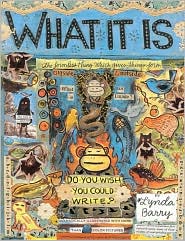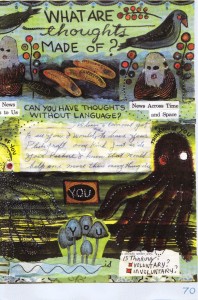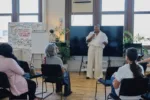Dozens of books on the market profess to help readers harness their creativity and find a better mode of expression through the arts. In the writing genre alone, they range from daily Sark-ian style watercolor inspirations to New Age-y healing journals, to a book that (rather efficiently) combines a diet plan with a writing regimen. What It Is, writer/artist/cartoonist Lynda Barry’s contribution to the field, is a different specimen.

Drawing from the “Writing the Unthinkable” classes Barry has been teaching for many years, the books serves as a graphic guide to the creative process. As suggested by the title, Barry explores the “what” as much as the “how” and “how-to.” While she doesn’t dispel the myth of the elusive imagination, she bravely goes traipsing through the darker places of the mind that cultivate it.
In mining her childhood for influences on her own work (alcoholic, abusive and neglectful parents, loneliness, poverty), Barry poignantly demonstrates that the creative drive often begins as a coping mechanism whereby repressed fears and unspoken anxieties find a home on the controllable page. Unfortunately, for too many of us, this important function gets lost amid the grown-up world of obligations, the pressure to succeed and “make something” of ourselves, and the need for approval. (Barry reveals that this happened to her as well, until she met a teacher who refused to grant her the approval she craved, with the frustrating result of sending her back to the drawing board again and again until she could only please herself.) For the rest of us, Barry offers a series of drawing and writing exercises along with clever tips (Create a bag full of clipped-out pictures! Write journal entries like visual snapshots!) to help us get back in touch with the childlike ways we used to observe the world. These are useful and intriguing, and her prompting questions naturally stimulate ideas.
As a guide to the artistic spirit, Barry is cheerful and frank, but what is most distinctive about this book are her collaged illustrations. Page after page layers sea creature figures over snippets of yellow legal pads with scrawled handwritten notes, washes of black watercolor and lines of text clipped from grade-school primers. The total effect mimics the overlapping structure of the subconscious itself as it churns, repeats and spits up ideas. It’s both a window into Barry’s mind and a brilliant representation of creativity at work.










